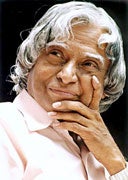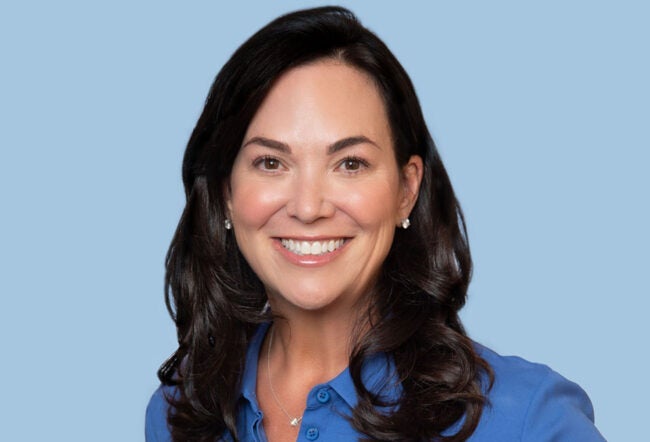APJ Abdul Kalam was among India’s best-known scientists before he became the country’s President. An alumnus of the Madras Institute of Technology, he worked for the Indian Space Research Organisation (ISRO) where he helped launch India’s first satellites into orbit. Later, Kalam worked on developing missiles and other strategic weapons; he was widely regarded as a national hero for leading India’s nuclear weapons tests in 1998. In 2002, Kalam was named the country’s President, and he held that position until 2007. During the Wharton India Economic Forum in Philadelphia, Kalam spoke with India Knowledge at Wharton about his career as a scientist, his vision for India’s future, and the most important traits for leaders, among other issues. An edited transcript of the interview follows:
APJ Abdul Kalam on Life Lessons
India Knowledge at Wharton: Since our publication is called Knowledge at Wharton, could you tell us something about knowledge?
Kalam: I’ve written a four-line, poem-like thing called “Creativity.” It goes like this: “Learning gives creativity. Creativity leads to thinking. Thinking provides knowledge. Knowledge makes you great.” I have made at least a million children repeat these lines. I am very happy that Wharton has created Knowledge at Wharton; it’s a beautiful idea. My greetings to all of you.
India Knowledge at Wharton: Perhaps we could begin by talking about your own past. You were born in Rameswaram in 1931. What are the biggest differences between India as it was then and India today?
Kalam: Since then I have orbited the sun 76 times. I have seen when I was a young boy the Second World War coming to an end, and the effect of war and injuries. I saw India attain her freedom in August 1947; I saw the economic ascent phase of India [beginning in] 1991. I have worked with visionaries like Prof. Vikram Sarabhai. I have seen the green revolution, the white revolution, and the telecom revolution; I have also seen the growth of information and communication technologies (ICT), as well as India’s successes in the space program and self-sufficiency in strategic weaponry. These are some of the things I have witnessed. Of course, we have a long way to go. Since we have to bring smiles to the faces of more than one billion people, we have many challenges ahead.
India Knowledge at Wharton: After studying aeronautics at the Madras Institute of Technology, you were one of India’s top scientists at the Defense Research and Development Organisation (DRDO) and then at the Indian Space Research Organisation (ISRO). You helped launch several successful missiles, which led to your getting the nickname, “Missile Man.” What challenges were involved in getting this program going and leading it successfully?
Kalam: I worked for ISRO for about 20 years. My team and I worked to put India’s first satellite into space. Then our team took up the Integrated Guided Missile Development Program. These were youthful teams that worked with me, and they have gone on to take up much larger projects. These in turn have led to great value addition in areas such as technology, infrastructure and, above all, human resources.
One of the important lessons I learned in the space and missile program was not just how to handle success but how to deal with failure. Wharton is in the management environment. I would like young people to understand how they should manage failure. In any project you take up, you will face problems. These problems should not become the captain of the project chief; the project chief should be the captain of the problems and defeat the problems.
India Knowledge at Wharton: You were actively involved in India’s nuclear weapons tests in 1998. Could you tell us about that experience and the lessons you learned?
Kalam: The main lesson I learned was how multiple technical teams and departments of the government of India could work together for a great mission as an industrial partnership. It was a great experience.
India Knowledge at Wharton: You are known to be deeply spiritual. Did you ever feel conflicted, or guilty, about developing missiles and nuclear weapons? Why, or why not?
Kalam: I realize that for my country’s development, peace is essential. Peace comes from strength — because strength respects strength. That is how our weaponized missiles were born. You need strength to keep the nation peaceful, so that you can focus on the necessary developmental missions. That is how I see it.
The Leadership Qualities of a President
India Knowledge at Wharton: How did you come to become India’s President in July 2002? What leadership qualities does one need to lead a country as large, complex and chaotic as India?
Kalam: Well, I won’t call India chaotic, because order comes from disorder. That is what is happening now.
I was elected President of India — from 2002 to 2007 — through a well-structured election process. Any leadership — whether it is political leadership or leadership in technology — requires that the leader have six traits. What are these traits?
First, the leader must have vision. Without vision, you cannot be a leader. Second, the leader must be able to travel into an unexplored path. Normally the tendency is for people to travel along well-laid out ways. Third, the leader must know how to manage success, and even more importantly, failure.
India Knowledge at Wharton: Could you give an example, from your own experience, of how leaders should manage failure?
Kalam: Let me tell you about my experience. In 1973 I became the project director of India’s satellite launch vehicle program, commonly called the SLV-3. Our goal was to put India’s “Rohini” satellite into orbit by 1980. I was given funds and human resources — but was told clearly that by 1980 we had to launch the satellite into space. Thousands of people worked together in scientific and technical teams towards that goal.
By 1979 — I think the month was August — we thought we were ready. As the project director, I went to the control center for the launch. At four minutes before the satellite launch, the computer began to go through the checklist of items that needed to be checked. One minute later, the computer program put the launch on hold; the display showed that some control components were not in order. My experts — I had four or five of them with me — told me not to worry; they had done their calculations and there was enough reserve fuel. So I bypassed the computer, switched to manual mode, and launched the rocket. In the first stage, everything worked fine. In the second stage, a problem developed. Instead of the satellite going into orbit, the whole rocket system plunged into the Bay of Bengal. It was a big failure.
That day, the chairman of the Indian Space Research Organization, Prof. Satish Dhawan, had called a press conference. The launch was at 7:00 am, and the press conference — where journalists from around the world were present — was at 7:45 am at ISRO’s satellite launch range in Sriharikota [in Andhra Pradesh in southern India]. Prof. Dhawan, the leader of the organization, conducted the press conference himself. He took responsibility for the failure — he said that the team had worked very hard, but that it needed more technological support. He assured the media that in another year, the team would definitely succeed. Now, I was the project director, and it was my failure, but instead, he took responsibility for the failure as chairman of the organization.
The next year, in July 1980, we tried again to launch the satellite — and this time we succeeded. The whole nation was jubilant. Again, there was a press conference. Prof. Dhawan called me aside and told me, “You conduct the press conference today.”
I learned a very important lesson that day. When failure occurred, the leader of the organization owned that failure. When success came, he gave it to his team. The best management lesson I have learned did not come to me from reading a book; it came from that experience.
India Knowledge at Wharton: That is a great story; thank you for sharing it.
Kalam: Continuing further with the six traits, the fourth trait is that the leader should have the courage to make decisions. Fifth, the leader should have nobility in management. Every action of the leader should be transparent. And finally, the leader should work with integrity and succeed with integrity.
All the traits apply especially to the President of a country. The President continuously must be in touch with the people. The Rashtrapati Bhavan [i.e., the presidential residence in New Delhi, India’s equivalent of the White House] must become the people’s residence. When I was President I travelled to every state, cutting across hills, deserts, and seas. I was in touch with millions upon millions of people.
India’s Future: The Economy, Energy Sector, and Social Grids
India Knowledge at Wharton: In your vision for India 2020, you envisaged that differences between the urban areas and the countryside would gradually disappear. Could you explain your concept of “PURA” and how that brings about this transformation?
Kalam: The concept of PURA — which stands for “Providing Urban amenities in Rural Areas” — is about giving a cluster of villages physical, electronic and knowledge connectivity. The idea is to empower the villagers, so that economic connectivity can emerge. We planned about 7,000 PURAs for the country — including hill PURAs, coastal PURAs and plains PURAs. I believe that connectivity is the key to bridging the rural-urban divide. The core-competence of the village will enable the production of competitive products for national and international markets. This will lead to rural enterprises which will create jobs in villages and lead to a vibrant economy in India’s hinterland. That is how prosperity will emerge in the rural environment.
India Knowledge at Wharton: How can India become energy independent by 2030?
Kalam: Today fossil fuels dominate the energy sector throughout the world. The World Energy Forum predicts that in five to eight decades, the fossil fuels will run out because these sources of energy are not renewable. Also, energy costs will go up. Oil is already at $110 per barrel, and if this continues, this situation will be very tough to manage.
So I set a goal of energy independence for my country. It’s a three-dimensional approach. First, we should invest in solar power. Today solar power is not economical because the efficiency of solar cells is just 15% to 20%. So we should use CNT (carbon nano tubes) composites that can increase the efficiency of solar cells to 45% or 50%. Second, we should use nuclear energy, because India has abundant thorium based nuclear reactors. This is definitely a clean solution to energy needs. The third focus area should be bio-fuels, including ethanol as well as bio diesel made from jatropha [a plant that grows in wastelands] and algae. These three initiatives can free India from dependence on fossil fuels. It will also help maintain a clean environment.
India Knowledge at Wharton: In your vision for India’s future technology plays an important role. How will social grids — such as the knowledge grid, the health grid and e-governance grid — help make India a developed country?
Kalam: The idea is that the knowledge grid empowers the village citizens with skill and knowledge. The health grid brings the super-specialty healthcare that is available in the cities to the doorsteps of rural citizens. And the e-governance grid brings transparent governance to the citizens. All these grids lead to economic growth and social transformation.
India Knowledge at Wharton: During your years as India’s president, what was the biggest leadership challenge that you faced and how did you overcome it?
Kalam: I returned the Office of Profit Bill to the Parliament. The reason was that I felt there was no transparent system for determining whether a post was an office of profit. That was a major decision. I studied the bill and returned it to the parliament for reconsideration. It created its own dynamic, but I felt I did the right thing.
India Knowledge at Wharton: If you could rewind and replay your years as President, what might you do differently? Is there anything you wanted to accomplish that you were unable to do?
Kalam: Last year I came up with an idea: I felt I should power the Rashtrapati Bhavan completely with solar power. For that I worked on a proposal after completing four years of my Presidential term — and at the beginning of the fifth year. But then the environmental agencies raised a lot of questions. Before I could answer them, my term ended. I would have liked the Rashtrapati Bhavan to be the first home in India to be powered completely by solar energy.
India Knowledge at Wharton: One last question — you are a gifted poet. Could you please recite some lines of your favorite poem?
Kalam: My favorite poem is “The Vision.” I recited it in Parliament, and I will recite it for you.
I climbed and climbed
Where is the peak, my Lord?
I ploughed and ploughed,
Where is the knowledge treasure, my Lord?
I sailed and sailed,
Where is the island of peace, my Lord?
Almighty, bless my nation
With vision and sweat resulting into happiness.



